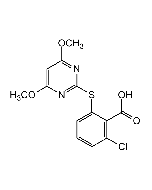Cookie Policy: This site uses cookies to improve your experience. You can find out more about our use of cookies in our Privacy Policy. By continuing to browse this site you agree to our use of cookies.
Chemodex
Prosulfocarb

| Product Details | |
|---|---|
| Synonyms | S-Benzyl dipropylthiocarbamate; BRN 4804364 |
| Product Type | Chemical |
| Properties | |
| Formula | C14H21NOS |
| MW | 251.39 |
| CAS | 52888-80-9 |
| Source/Host Chemicals | Synthetic. |
| Purity Chemicals | ≥97% (NMR) |
| Appearance | Buff or brown liquid. |
| Solubility | Soluble in chloroform, ethyl acetate, acetone, ethanol or methanol. Insoluble in water. |
| Identity | Determined by 1H-NMR. |
| Declaration | Manufactured by Chemodex. |
| Other Product Data |
Click here for Original Manufacturer Product Datasheet |
| InChi Key | NQLVQOSNDJXLKG-UHFFFAOYSA-N |
| Smiles | O=C(SCC1=CC=CC=C1)N(CCC)CCC |
| Shipping and Handling | |
| Shipping | AMBIENT |
| Short Term Storage | +4°C |
| Long Term Storage | -20°C |
| Handling Advice |
Keep cool and dry. Protect from light and moisture. |
| Use/Stability | Stable for at least 2 years after receipt when stored at -20°C. |
| Documents | |
| Product Specification Sheet | |
| Datasheet |
 Download PDF Download PDF |
Thiocarbamate herbicide. Targets the meristematic region, or growing points, of plants, on both roots and shoots. Mode of action is through inhibition of lipid synthesis in plant cells. In particular, it inhibits fatty acid elongase enzymes, altering cell membranes and disrupting vital cell processes. It also effects the development of cutin and suberin, two waxy polymers that help to form plant cuticles. The result is that meristems are inhibited, root and shoot development is stunted, new leaves fail to emerge and shoots twist and turn dark green. Used for post-emergence control of grass and broad-leaved weeds in a wide range of crops. Compound can be used as analytical reference material.
(1) D.Callens & R. Bulcke; Meded. Fac. Landbouwwet, Univ. Gent 60, 141 (1995) | (2) The Pesticide Manual, 11th Edition: C. Tomlin; British Crop Protection Council (1997) | (3) M. Gennari, et al.; J. Environ. Sci. Health B 37, 297 (2002)













